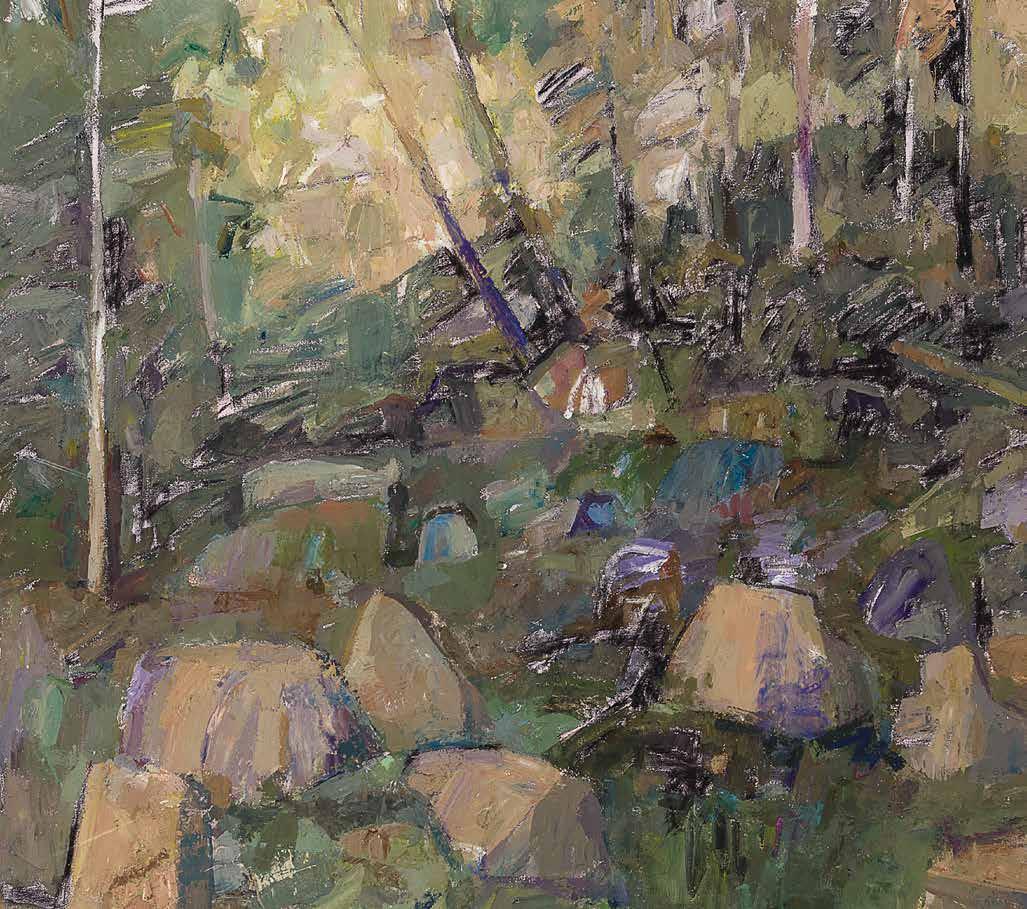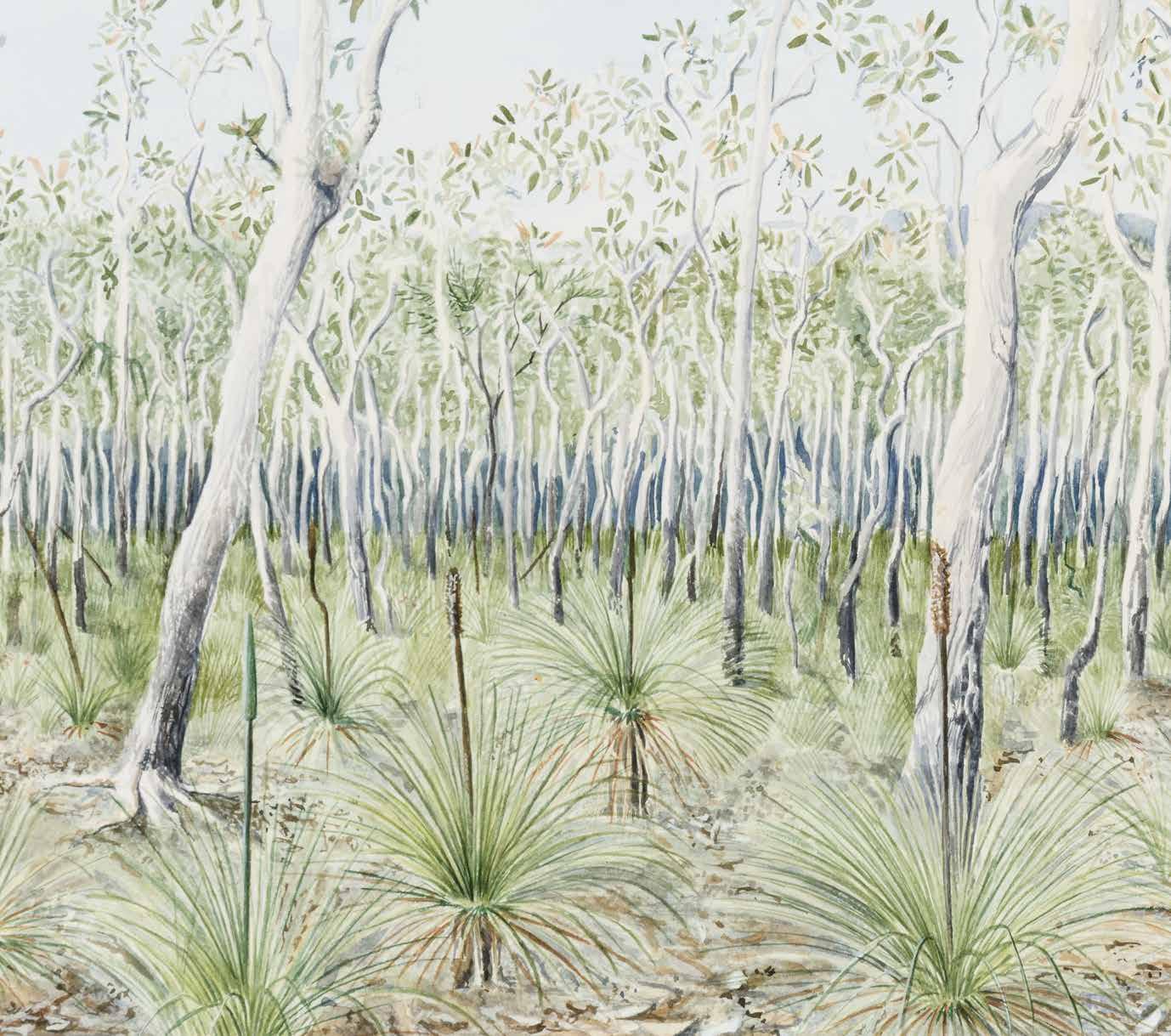JAMES COOK UNIVERSITY, ART EDUCATION AND THE TOWNSVILLE COMMUNITY OF ART PRACTITIONERS
Townsville’s rocky landscape, tropical climate and rich ecology - dominated by its proximity to the sea and dry coastal hinterland - provide a powerful determinant in shaping perceptions of place. As noted by Urszula Szulakowska, in her ground breaking study, Experimental Art in Queensland 1975-1995, ‘it is not surprising that the artistic community has a strong sense of identity and loyalty to the area’.1 Prior to the 1960s, the northern region lacked a contemporary visual culture particular to itself since those artists who made their name depicting the northern tropics, such as John Coburn2 and Ray Crooke, did not create permanent artistic infrastructure. Not that this was a particular goal of these artists in any case.
The artists central to the development of Townsville’s artistic identity did not arrive until the 1960s and 70s. The main contingent came in the mid to late 1970s and was associated with art education. With the full accreditation of fine art courses at the School of Art and Design of the Townsville College of TAFE in 1978, Townsville became the first regional city in Queensland to provide full-time tertiary art training. The establishment of fine art courses at James Cook University (JCU) followed twelve years later.
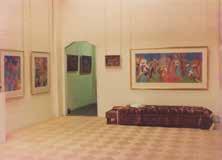
The first intake of art instructors in Townsville included the artists David Blackman and Robert Preston, who were English born and trained and brought with them a direct knowledge of contemporary British art. The TAFE course had been established by Jim Cox, who came to Townsville in 1975 to set up the facilities and hire teaching staff. Anne Willis, also English born, taught at the College of Advanced Education.3 Another artist who brought first-hand experience of contemporary European art was Anneke Silver, who settled in Townsville in 1961. Trained in Amsterdam, she came into contact with contemporary art movements of De Stijl and the CoBrA groupespecially the painters Appel and Corneille.
By the beginning of the 1980s there had emerged an impressive but disparate group of artists based in Townsville. Although most were attached to TAFE, they were committed to their own practice and to maintaining a regular exhibition profile in Townsville. The strong sense of solidarity enjoyed by this group was reinforced by their status as new arrivals. Their anonymity, as far as the rest of Australia was concerned, was reinforced by a cultural system that was largely uninterested in regional Australia and its artists. As a group they were doubly disadvantaged.
15 Celebrating Townsville
Ralph Martin Gallery interior featuring works by Ron McBurnie from his exhibition Cyclone Winifred, 1987.
Photograph: Ron McBurnie
Townsville’s artists were well supported by the Townsville-based Martin Gallery, which was established in 1972 by Ralph Martin. Many north Queensland artists had their first exhibitions at this gallery as it was one of the few commercial galleries of its kind outside of Brisbane. It started in the same year as the Ray Hughes Gallery in Brisbane and pre-dated other more prominent Brisbane commercial galleries, such as Philip Bacon Galleries and Victor Mace Fine Art. Ralph Martin’s role in developing a market for contemporary art in north Queensland and in supporting northern artists is still largely unrecognised. An exhibition relating to this history is to be presented by Perc Tucker Regional Gallery in 2016.4
By the mid 1980s, there was a core group of professional artists based at the TAFE art school. They included James Brown, Phil Davis, Jane Hawkins, Anne Lord, Ron McBurnie, Robert Preston, Anneke Silver and Margaret Wilson. Both James Brown and Robert Preston were particularly influential in developing the status of the TAFE course and its reputation for excellence in drawing.5 Although there was little sense of a ‘Townsville school of art,’ there were obvious areas of common concern, the most apparent being a strong tradition of landscape-based forms.
Preston and Silver, in particular, brought knowledge of European art school traditions to north Queensland. They encouraged their students to look beyond the immediate influences of contemporary Australian painting and to include the study of the art of Europe, Asia and the Middle East as well as the classical world. Both were outsiders and were not influenced by Australian art school training. They were not acculturated by the Australian art education system and this had a strong influence on what they taught. The artistic work created by lecturers and students was to become distinct historically and thematically from Brisbane and constituted a unique contribution to Australian contemporary visual culture as is evidenced by the tenor and quality of the work that these artists created in somewhat isolated circumstances. This was a point noted by visiting artist, John Olsen, who was surprised to meet such high calibre artists in Townsville during one of his visits in the late 1970s.6
16 Celebrating Townsville
Anneke SILVER
b.1937 Holland
The Contents of the Rainmaker’s Pouch 1997 Mixed media and collage on paper, 96 x 169 cm

Purchased for the James Cook University Art Collection via the English Department, 1997
Photograph: Michael Marzik
17 Celebrating Townsville

18
Celebrating Townsville
Robert PRESTON
b. 1942 United Kingdom
S’labicated Monument 1 2010
Charcoal and black chalk on paper
55 x 75 cm
Collection of the artist
Photograph: Michael Marzik

19
Celebrating Townsville
Robert PRESTON b. 1942 United Kingdom S’labicated Monument 2 2010 Charcoal and black chalk on paper 55 x 75 cm
Collection of the artist
Photograph: Michael Marzik
While the University College of Townsville had been established in 1960, and James Cook University of North Queensland was proclaimed in 1970, it wasn’t until 1 January 1991 that TAFE’s accredited art courses were discontinued7 and became part of a creative cluster within the JCU College of Music, Visual Arts and Theatre (COMVAT) at the suburban Vincent Campus.8 The courses were innovative and included studio-based majors in five named degrees and postgraduate research programs. There was an emphasis on artmaking skills and conceptual development. As part of a broad redesign of creative arts training in early 2005, the courses embraced new media and were rewritten with a motivation to broaden graduate capabilities for a changing workforce, focusing on digital art forms. This inevitably led to the perception that the decline of traditional studio-based teaching would impact on skills-based learning. Throughout Australia, undergraduate art degrees have assumed a more ‘generalist’ profile with the decrease in studio contact hours.
Distant from the state capital, Townsville is at once isolated from decision makers in Brisbane but also free to pursue its own cultural agenda. The development of professional arts networks in Brisbane by the mid 1960s can be mapped by focusing on its key structures and individuals. These ingredients are essential for a lively, self-sustaining ‘pool’ of creative talent. Brisbane, by virtue of its status as a capital city, naturally brought together creative
expertise, funding and institutional support. The opposite is true of Townsville, which experienced constant dissipation of resources and a creative brain-drain to the south and elsewhere. Nevertheless, Townsville’s unique cultural individuality is based on a strong, independent identity and history.
To some degree, Townsville now emulates Brisbane as it was before its cultural resurgence in the 1980s when many new cultural institutions were established. While it is true that Townsville’s institutions - including Umbrella Studio and Perc Tucker Regional Gallery - are significant, they also struggle with existing infrastructure. Umbrella Studio was established in 1986 as a working studio for a group of emerging Townsville artists. It was the only artist-run initiative and the first professional artist organisation north of Brisbane. Umbrella Studio’s role has expanded and it is active in creating a platform for local artists and positioning emergent contemporary art practice into its mainstream programming. One of the more decisive events in its early history was presentation of the Off Centre-art and regionalism conference in 1991 and a spinoff exhibition.9
20 Celebrating Townsville
Anneke SILVER
b.1937 Holland
The last of the good water 2015 Charcoal, oil and mixed media on canvas 76 x 153 cm
Collection of the artist Photograph: Michael Marzik

21 Celebrating Townsville
When Perc Tucker Regional Gallery opened its doors in 1981, it was the first regional gallery of its kind in northern Australia. It has proved vital in supporting and promoting contemporary north Queensland artists and has developed collection and exhibition policies which give special attention to the creative arts of this region. Achievements in research and publishing are traditional benchmarks for any art museum. This Gallery has a prolonged history of fulfilling these roles. It is recognised nationally for its contribution to curating surveys of north Queensland artists whose production has become distinct historically in terms of the Australian art canon. It is largely through the efforts of the Perc Tucker Regional Gallery that the artist communities in Townsville and north Queensland have been recognised nationally.
While the Martin Gallery closed permanently in 1987, its role was filled by two galleries closely associated with each other. The first of these was Tonnoir’s Fine Art Gallery which, from its Flinders Street West location, became active as a commercial exhibiting space. Paul and June Tonnoir held thirty exhibitions before relinquishing it to Anne Carter in 1992. The second was Flinders Gallery (the Tonnoir’s Fine Art Gallery rebranded), which became a significant presence before it finally closed in late 2007. Fittingly, the final solo exhibition was the work of James Brown who also presented the first exhibition held by the Tonnoirs in 1989.
James Cook University’s own collection was established under the guidance of Associate Professor Ron Kenny during the 1960s. Although its brief for collecting was limited, there are key works by Australian artists such as Ray Crooke, Sam Fullbrook, Guy GreySmith, Margaret Olley, Clifton Pugh, Grace Cossington Smith and Roland Wakelin. There are also important holdings by the artists most associated with Townsville’s artistic identity, including James Brown, Jane Hawkins, Anne Lord, Ron McBurnie, Robert Preston and Anneke Silver; works that are central to this exhibition.
The body of work that forms the basis of this exhibition has its genesis in this recent history. It focuses on a remarkable group who are connected by virtue of their status as dedicated professional artists and the nexus between their own creative practice, university-centred teaching of studio-based fine art, and the lineage between teacher and student – particularly where there is continuity and an engagement with studio art making. It is these artists and their representation within the JCU Art Collection that provide a striking creative pivot to this exhibition and it is probably the first time that a particular body of the Collection has been used to focus on Townsville’s own artistic history.
22 Celebrating Townsville
Celebrating Townsville

23
Associate Professor Ron Kenny, viewing an exhibition held in the 1960s in the University College Pimlico Refectory.
Photograph: James Cook University Records.
It has been noted that the artists who were central to Townsville’s artistic identity brought knowledge and perspectives that were progressive and went beyond the direct influences of the Australian canon. Nowhere is this more evident than in the work of James Brown, Ron McBurnie, Robert Preston and Anneke Silver. Silver’s work throughout the 1970s and early 1980s was characterised by a quest to embody the essence of the landscape through a symbolic use of earth colours and a system of painterly-abstraction. In the 1990s, her work was centred on mythologies of the earth and the concept of the sacred feminine. This engagement with the immediate landscape and environment is a particular aspect of the core group, as well as the younger practitioners who provide a counterpoint in this exhibition.
Trained in London, Robert Preston was directly influenced by an English movement of artists who were reassessing the traditions of European painting and emphasising objective realism. Through his lecturer, Euan Uglow, Preston became preoccupied by the system of measured drawing or measuring by proportion from a fixed point. While this was not to be his only influence, it established for Preston a system of finding exactly comparable or divisible distances. This was to come to the fore in his own teaching after his arrival in north Queensland. His work has shifted between the formal, abstract works of the 1970s to a more narrative style which
corresponds in part with his study into the mythology of non-European cultures. This play between abstraction, narrative and ‘plein airism’ marks out Preston’s intriguing practice.
Through their activities as teachers and researchers,10 James Brown, Jane Hawkins, Anne Lord, Ron McBurnie, Robert Preston and Anneke Silver have had a strong influence in shaping what has followed in terms of creative practice. Many of the succeeding artistic generations in Townsville acknowledge this powerful influence.11 This determined focus on studio-based teaching became one of the defining attributes of their art training. The influence of artists in residence at the art school and the location of Lyrebird Press were also critical in strengthening professional standards in art education at JCU.12 Printmaking, in particular, has a strong base in Townsville and this is largely due to the inspired teaching of both Anne Lord and Ron McBurnie.13
24 Celebrating Townsville
James BROWN
b.1953 Australia
Hervey’s Range 1992
Encaustic on canvas
144 x 114 cm [each panel]
Donated by the Artist in 1992 to the James Cook University Art Collection
Celebrating Townsville

25
Photograph: Michael Marzik
Anne Lord was born in north west Queensland and trained initially with Mervyn Moriarty at Eastaus (the forerunner to Flying Art School), then at East Sydney Technical College (later Alexander Mackie CAE) Sydney, before arriving in Townsville in 1979. While an instructor at TAFE, an external postgraduate diploma of printmaking was awarded to her from Monash University, Gippsland, in 1992. Although she works across a broad range of media that includes printmaking, painting, photography and installation as well as digital media, it is through printmaking that Lord first gained recognition. She has described her work as being ‘founded in concerns of place and environment, exploring the dramatic tropical seasons, growth and decay, monsoon, floods, grasslands, drought and bushfires of north Queensland.’14 Moving away from explorations of her relationship to the land through colour and symbol, Lord became engaged in a more politically critical practice, including an examination of land use. Her recent 2012 digital work blurs the boundaries between drawing and digital imagery. Found objects collected over decades, declared as shards or trinkets, are used to investigate passages of time in material and historical capture.
Digital Print
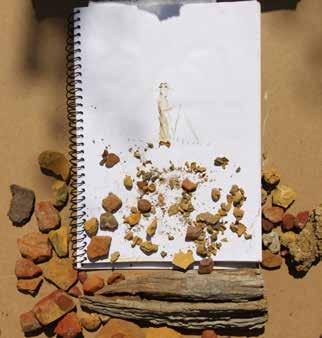
26 Celebrating Townsville
Anne LORD b.1953 Australia left: Shards and earth – Surveyor: difference between ochre and card 2012
39.2 x 32 cm
Collection of the artist
Photograph: Anne Lord
Digital


27 Celebrating Townsville
Anne LORD b.1953 Australia
Shards – For a Fire Ravenswood: difference between glass and resin 2012
Print
32 x 45.7 cm
Collection of the artist
Photograph: Anne Lord
Anne LORD
Shards – Walking on the Beach: difference between sand and wood 2012
Digital Print
43.8 x 32 cm
Collection of the artist
Photograph: Anne Lord
Ron McBURNIE
b.1957 Australia
A Rake’s Progress – ‘Sale of the Century’ I 1990
Hard ground etching and aquatint

49.5 x 74 cm
Edition 24/30
Purchased for the James Cook University
Art Collection in 1993
Photograph: Michael Marzik
28 Celebrating Townsville
Ron McBURNIE
b.1957 Australia
A Rake’s Progress – ‘Sale of the Century’ II 1990
Hard ground etching and aquatint

49.5 x 74 cm
Edition 24/30
Purchased for the James Cook University
Art Collection in 1993
Photograph: Michael Marzik
29
Townsville
Celebrating
With full-time art training and opportunities for postgraduate study, artists moved to Townsville from all over the north and from elsewhere in Australia. A strong part of the education model at JCU was to take students on excursions to work directly in the landscape. These experiences were to have a profound influence on a number of students, who grappled with issues of connectedness with place. Australia is one of the most urbanised nations on earth, yet the enduring myth of Australia is based on rural and outback imagery. The tropics have not escaped this form of myth-making. Ron McBurnie is an artist who has consistently delved into the suburban psyche of north Queensland since his arrival in 1980. His works chart some of the rituals and peculiarities of that zone between the suburbs of Townsville and the tropical hinterland. McBurnie’s practice shifts between printmaking, artist books, painting and drawing. Peripatetic by nature, the subject matter of many of his recent works is derived from his frequent travels in Australia, New Zealand and Europe. His landscape images draw inspiration from early traditions of British and European printmaking and painting.
Ron MCBURNIE
b.1957 Australia
The Oberon Tree [detail] 2010 Ink and watercolour on paper 76 x 109 cm

Collection of the artist
Photograph: Michael Marzik
30 Celebrating Townsville
b.1957 Australia
The Oberon Tree 2010

Ink and watercolour on paper
76 x 109 cm
Collection of the artist
Celebrating Townsville
31
Ron MCBURNIE
Photograph: Michael Marzik
In a creative sense, all the artists who are central to this exhibition are kindred spirits and they share a common love of working out of doors which allows for portable, convenient and adaptable working methods to suit different local situations and subject matter. This interest in ‘plein air-ism’ unites the entire group including, perhaps a little surprisingly, Jane Hawkins, who is better known for her more formal commemorative sculpture commissions in bronze and her life-like female nudes. In her more intimate studio work, Jane Hawkins recalls memories of childhood play and experiences of nature.
Jane Hawkins trained in Brisbane before taking up the position in sculpture at TAFE and later JCU. Her work shifts between domestic-scale installations to life-size human figures. In 1990 she carried out a series of sculptures based on poses that were taken from selected figures in British painter Euan Uglow’s figurative paintings – derived from real object sources. This intriguing transformation from painted image to a human scale ceramic form in these sculptures is revealing as Hawkins enters into the psychology of the figure by exploring Jungian archetypes in relation to personality types. The work from the JCU Art Collection is the first sculpture in the series and although the pose is based on one of Euan Uglow’s own female figures, the work is essentially a self-portrait.
Jane HAWKINS
b.1958 Australia
Recognition [detail] 1990
Clay overpainted with acrylic 181 cm high

Purchased for the James Cook University
Art Collection in 1991
Photograph: Michael Marzik
32 Celebrating Townsville
Jane HAWKINS
b.1958 Australia

Recognition 1990
Clay overpainted with acrylic
181 cm high
Purchased for the James Cook University
Art Collection in 1991
33
Townsville
Celebrating
Photograph: Michael Marzik
Picture Block Seats with Cushions: Fingerprint, Lotus, Sticks/Stones/Bones, Ant Track 2012
MDF, trapunto/quilted cushions

Each block 40 x 40 x 40 cm
Collection of the artist
34 Celebrating Townsville
Jane HAWKINS b.1958 Australia
Photograph: Michael Marzik
Jane HAWKINS
b.1958 Australia
object 1:
Arch Window: Reliquary 2012

Wood, cloth, cast iron
27 x 21.5 x 8 cm
Private Collection
Photograph: Michael Marzik
object 2:
Round Window: Treasured Memories 2012
Wood, cloth, plumb-bob, gold leaf, stones
21 x 21 x 5 cm
Private Collection
Photograph: Michael Marzik
object 3:
Square Window: I had a little nutmeg 2012
Wood, cloth, card, cast bronze, gold leaf
21.5 x 21.5 x 7 cm
Private Collection
Photograph: Michael Marzik
35 Celebrating Townsville
James Brown returned to Townsville from Brisbane in 1978 to teach at TAFE and continued in this capacity until the transfer of courses to JCU. As an artist he is engaged in drawing, painting, printmaking, publishing artist’s books and sculpture. Beyond professional practice as an artist, he has a strong interest in the etchings of the Barbizon Group (nineteenth-century French artists) and Dutch, German and English landscape prints from the fifteenth to the nineteenth century. These influences are particularly relevant in a recent series of landscapes which assimilate historical references quoting aspects of Constable and Strang. This shift between the painterly-abstraction of his early landscapes to the more refined European endowed images, loaded with historical precedents, makes for a fascinating body of practice.
36 Celebrating Townsville
Referencing Strang 2011 Oil on canvas
100 x 80 cm
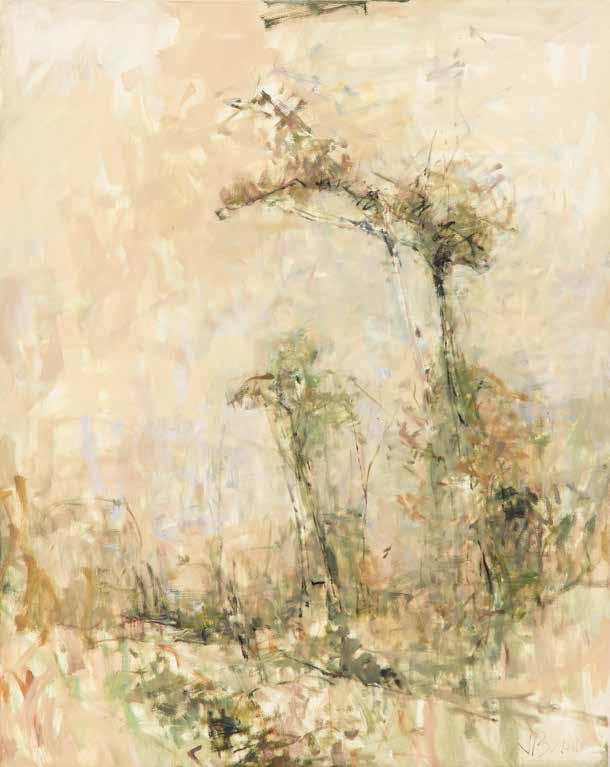
Collection of the artist
Celebrating Townsville
37
James BROWN b.1953 Australia
Photograph: Michael Marzik
An intriguing aspect of this exhibition is that the range of work, while at once striking, is not so much a question of variety as one of contrast. This is particularly true of the next generation who were students of the core group but have gone on to establish their own creative range. Art training in Townsville fashioned an industrious and creative learning environment in which making art was integrated with philosophy. Indeed the dominant model of art schools in the 1970s and 80s was ‘about making great artists.’15 The artists who form the counterpoint to this exhibition are Daphne Cazalet, Barbara Cheshire, Sheree Kinlyside, Alison McDonald, Jill O’Sullivan and Lucy T. Smith. All but Cazalet and Smith reside in the north. The strong emphasis on studio-practice and the opportunity for greater specialisation in postgraduate study has seen almost all of the next generation pursue graduate research with three completing PhDs or Doctorates including Cazalet, Cheshire and O’Sullivan.
Excellence in drawing is one of the hallmarks of Townsville’s art school training and much of this reputation is based on Robert Preston’s teaching methods. This lineage is certainly evident in Preston’s student, Lucy T. Smith, who is based in the United Kingdom and is an internationally recognised botanical illustrator. It was not until her travels took her to north Queensland in the 1990s that her career as a botanical artist began. In 1994 Smith illustrated the plants growing in the Melaleuca woodlands
for her Honours project. She then freelanced as a zoological and botanical illustrator producing paintings of palms and drawings of dugongs, whilst tutoring in visual arts. In 1997–1999 she painted eighteen detailed studies of north Queensland palms in their natural habitats for her Masters in Creative Arts. In 2000, she arrived at the Royal Botanic Gardens, Kew, to begin illustrating the ambitious Palms of New Guinea project.
Daphne Cazalet, a student of Anneke Silver (who supervised her BVA with Honours at JCU), produced a striking body of large, coloured, figure drawings and paintings, one of which was acquired for the JCU Art Collection. Cazalet was awarded a doctorate in visual arts in 2009 at Charles Darwin University, Darwin, with a body of work centred on embodying post-colonial, personal and political attitudes to mixed-cultural identity and race. Now resident in southern Italy, Cazalet has an extensive history of working professionally with communities through theatre and other art forms.
38 Celebrating Townsville
Daphne CAZALET (student of Anneke Silver)
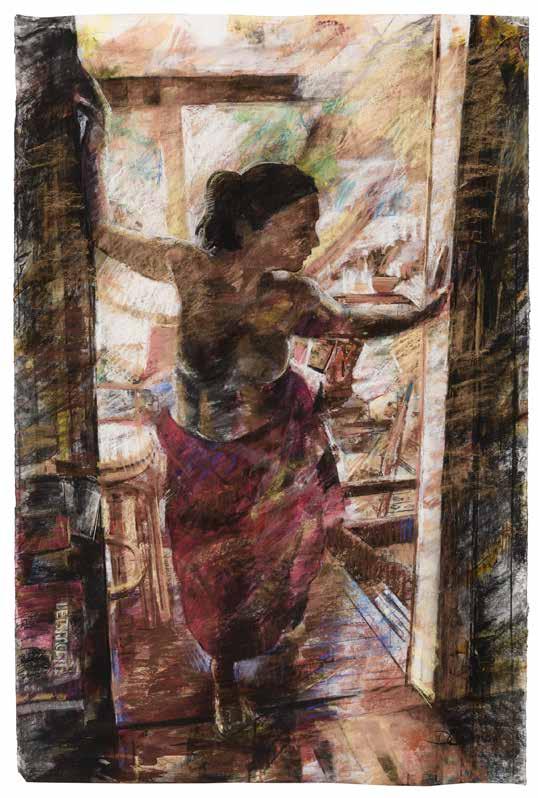
b. India
On Entering II 2001
Mixed media
153 x 100 cm
39
Celebrating Townsville
James Cook University Art Collection via the Harry Hopkins Memorial Award, 2001
Photograph: Michael Marzik
Lucy T. SMITH
(student of Robert Preston)
b.1968 Australia
Grass Tree Xanthorrhoea johnsonaii 1994

Watercolour on illustration board with printed overlay
43 x 21 cm
James Cook University Art Collection
Photograph: Michael Marzik
40 Celebrating Townsville
Lucy T. SMITH
b.1968 Australia
Apollo Jewel Butterfly 1994
Watercolour on illustration board with printed overlay
40 x 30 cm
Purchased by the Botany Department for the James Cook University Art Collection 1994

Photograph: Michael Marzik
Lucy T. SMITH
b.1968 Australia
Gecko 1993

Watercolour on illustration board with printed overlay
27 x 20 cm
James Cook University Art Collection
Photograph: Michael Marzik
41 Celebrating Townsville
The discernible legacy between teacher and student, particularly where there is continuity and an engagement with studio practice, is especially true of the graduates who continue to live in Townsville. Sheree Kinlyside and Jill O’Sullivan share a common history as printmakers through their studies with Ron McBurnie and Anne Lord. While O’Sullivan has maintained her interest in printmaking, Sheree Kinlyside has also found expression through the artist book form and its capacity to use text and image in a complementary manner.16
Kinlyside is owner, designer and printer at Red Rag Press, the north’s only fully equipped letterpress, etching and bookmaking studio. In the ‘Fold – Liturgy’ works she has torn and folded pages from several old bibles and included them in three-dimensional artworks. This poses intriguing questions about the value of the handmade book and the implications of co-opting, transforming and creating new contexts from such ‘culturally’ specific materials.
Sheree KINLYSIDE
(student of Ron McBurnie)
b.1955 Australia
Fold – Liturgy III [detail] 2014

Acrylic sheeting, box card, bible pages, wire, metal finding, iron shavings in acrylic paint
26.5 x 26.5 x 36.7 cm
Collection of the artist
Photograph: Michael Marzik
42 Celebrating Townsville
Sheree KINLYSIDE
b.1955 Australia
object 1: Fold – Liturgy I 2014
Acrylic sheeting, box card, bible pages, wire, metal finding, iron shavings in acrylic paint
11.5 x 11.5 x 30 cm
Collection of the artist
Photograph: Michael Marzik
object 2: Fold – Liturgy II 2014
Acrylic sheeting, box card, bible pages, wire, metal finding, iron shavings in acrylic paint
15.3 x 15.7 x 36 cm
Collection of the artist
Photograph: Michael Marzik
object 3: Fold – Liturgy III 2014
Acrylic sheeting, box card, bible pages, wire, metal finding, iron shavings in acrylic paint

26.5 x 26.5 x 36.7 cm
Collection of the artist
Photograph: Michael Marzik
43 Celebrating Townsville
Jill O’Sullivan’s lithographs explore a range of art historical responses to people and places, especially in a work referencing images of the annunciation. Her work makes use of light and dark in black and white to create certain dramatic effects, and a dimensional nuance created by the doorway opening up on the interior scene. The image was developed through compositional drawings relating to drawings and photographs of friends posing in domestic settings.

Jill O’SULLIVAN
(student of Anne Lord)
b.1941 Australia
The Annunciation 2000
Lithograph
47.5 x 32 cm
Edition 2/7
Collection of the artist
Photograph: Michael Marzik
44 Celebrating Townsville
Jill O’SULLIVAN
b.1941 Australia
Domestic Artefact 2006
Lithograph
25 x 37.2 cm
Edition 7/10
Collection of the artist
Photograph: Michael Marzik

45
Celebrating Townsville
Widely respected sculptor and installation artist Alison McDonald has centred her recent practice on revaluing everyday materials including discarded PET bottles and plastic components. While her early work demonstrates a connection to the figure, her PET assemblages are expansive and are often presented in site specific contexts. The work
R. R. R. (Reduce, Reuse, Recycle) was created whilst on residency in Aberystwyth, Wales. Originally titled ‘Choker’ to resemble an oversize piece of jewellery, its purpose was to play on the idea that it was made of rubbish that ‘choked’ our waterways.
It has been said of Barbara Cheshire that, in every work, the driving force remains the same: representing ‘complete human experience’ –the marriage of the physical and the spiritual. Thus, we have the integration of senses and soul. This recognition and celebration of the spiritual is a theme that has underpinned much of Cheshire’s artistic career.17 This is most evident in a recent series of paintings where she creates a fine weaving of minute brush strokes that speak of her inner and outer responses to the spiritual.
This fascinating body of work alludes to a complex, rich history of practice. The artists are connected by both formal associations as students and teachers but also by what they share in terms of common experiences. What unites them is a deep engagement to studiopractice and artistic enquiry. The history of
art education in Australia is not an area of active research or focus but clearly universitycentred teaching of studio-based fine art has made a compelling contribution to building a significant community of art practitioners in Townsville.
Alison McDONALD (student of Jane Hawkins)
b.1962 Australia
R.R.R. (as in Reduce, Reuse and Recycle) [detail]
2012-2015
Hand cut and coloured recycled PET plastic, silver-coated wire

68 x 20 x 38 cm
Collection of the artist
Photograph: Michael Marzik
46 Celebrating Townsville
Alison McDONALD
b.1962 Australia
R.R.R. (as in Reduce, Reuse and Recycle) 2012-2015 Hand cut and coloured recycled PET plastic, silver-coated wire 68 x 20 x 38 cm

Collection of the artist
Photograph: Michael Marzik
47
Townsville
Celebrating
Barbara CHESHIRE
b.1946 Australia
Universal Pulse 1 2016
Oil on canvas
76 x 123 cm
Collection of the artist
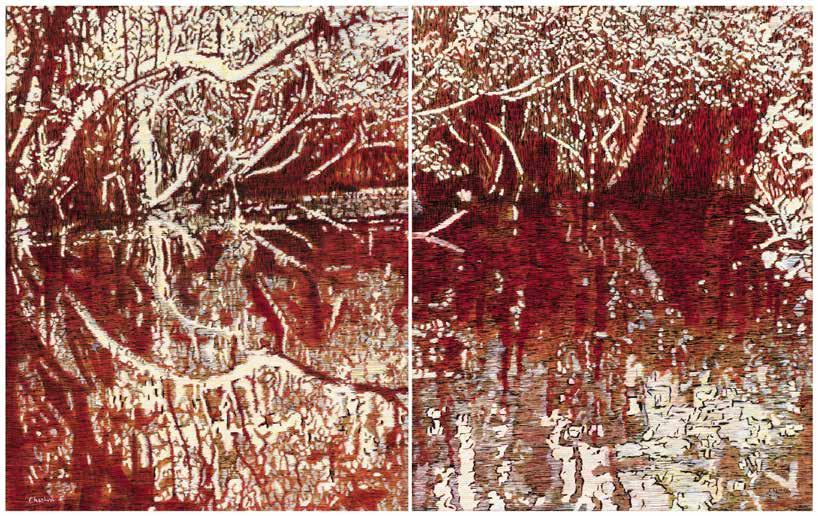
48
Celebrating Townsville
(student of James Brown)
Photograph: Michael Marzik
